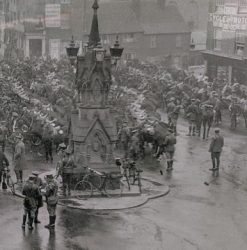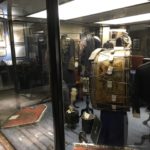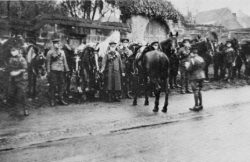The Local Regiments in WW1
The Royal Warwickshire Regiment

One of the oldest regiments in the British Army, The Royal Warwickshire Regiment (RWR) played a prominent role in World War I. After various army reorganisations, it is now part of The Royal Regiment of Fusiliers.
The regiment was raised in 1674 and formally established in 1685. Originally known as ‘The Sixth of Foot’, it became the 1st Warwickshire Regiment in 1782, adopting Warwickshire Lads as its ‘quick march’ – this can be heard every Friday played on St. Mary’s chimes. The regimental mascot is a black antelope or Indian Buck, and its patron saint is St. George.
Men from the RWR played a major role on the Western Front in WWI. The regiment lost 11,610 men. Six were awarded the Victoria Cross for outstanding bravery. One of those seriously wounded in the first battle of Ypres was a Lieutenant Montgomery, who went on to lead the British forces in WWII. His banner hangs in St. Mary’s Church, outside the Regimental Chapel in the north transept.
The Regimental Chapel at St. Mary’s
The RWR Chapel was established in the Collegiate Church of St. Mary after WWII and features a stained glass window by Philip Chatwin honouring those from the regiment who had given their lives in war. In 1952 the Regimental Chapel was dedicated by the then Chaplain General and the stained glass window was unveiled by Field Marshal the Viscount Montgomery of Alamein.
In the church to the right of the chancel is a monument in the style of a tomb, made of alabaster and marble, dedicated to the Warwickshire troops who died in WWI.
Their names are inscribed in a book displayed in a glass case on top of the shrine; a page is turned each day. Volunteer churchwardens will help you look for a particular name if you wish.
In 2018, to mark the centenary of The Armistice, Warwick people and local organisations hand-made thousands of poppies with the target of producing one for each of the 11,610 members of the RWR who gave their lives in the 1914-18 war. Knitted, crocheted and painted poppies arrived from all over the world. In the end there were over 62,000 decorating the church in a spectacular display, with the medieval Beauchamp Chapel reserved for children’s displays. The project was called ‘Warwick Poppies 2018’
The Fusilier Museum Warwick
The museum has recently relocated to Pageant House, Jury Street, Warwick and contains fascinating displays and artefacts relating to the three centuries of history of the regiment.
There is a World War 1 Trench Experience with displays of items belonging to Warwickshire Soldiers in the conflict. Audio and visual displays and interactives explore the sights and sounds (and even smells) of the Great War.
https://fusiliermuseumwarwick.com/research for details of the museum’s research service
The Warwickshire Yeomanry

The Warwickshire Yeomanry (WY) was a volunteer cavalry regiment, formed in 1794 during the Napoleonic wars. All Lord Lieutenants had received a government circular requesting the recruitment of cavalry consisting of ‘Gentlemen and Yeomanry’.
In 1907 with the formation of the Territorial Force, the Warwickshire Yeomanry became the Cavalry Unit of the County Force, and with yeomanry regiments from Gloucestershire and Worcestershire, and with the newly formed Battery of Warwickshire Royal Horse Artillery, formed the 1st South Midland Mounted Brigade of the Southern Command, with headquarters at 12 Northgate Street.
The Warwickshires served in the Boer War and in WWI – with distinction in Gallipoli, Egypt and Palestine. In the famed so-called ‘Affair of Huj’ in Palestine, the Yeomanry charged the artillery positions of the Turkish and Austrian forces, capturing the guns. It was the last unsupported cavalry charge in military history. During WWII the horses were gradually replaced by tanks.
The Warwickshire Yeomanry Museum


The Warwickshire Yeomanry Museum is housed in the former kitchens and storerooms in the basement of the Court House in Jury Street/Castle Street, below the Visitor Information Centre. It is full of interesting artefacts, including one of the guns captured at Huj. There are uniforms, weapons, medals, photos, documents and helpful volunteers who can explain the rich history of the county Yeomanry and Royal Horse Artillery.
The museum is open at weekends and on bank holidays from Easter to early November. It is free to visit, is run by volunteers and relies entirely on donations. (With thanks to the Trustees of the Warwickshire Yeomanry Museum)
There is more information on their website, and a form to request service records of WY members – see also our ‘Do Your Own Research’ for more information.
Warwickshire Royal Horse Artillery

The Warwickshire Royal Horse Artillery (WRHA) was a Territorial Force raised by Lord Brooke in 1908, and became known as ‘Brooke’s Battery’. Its temporary headquarters was in the Warwick Castle stable block before moving to Clarendon Place in Leamington Spa.
In 1914 it was the first territorial force artillery unit to go overseas on active service, spending the whole of WWI on the Western Front. The role of the unit was to support the frontline cavalry brigades with its four horse-drawn field guns.
The WRHA took part in many of the major battles of the war, including the 2nd Battle of Ypres, the Battle of Arras, the 3rd Battle of Ypres, the Battle of Cambrai and the Final Advance into Flanders.
 The Roll of Honour
The Roll of Honour
The Warwickshire Royal Horse Artillery suffered heavy losses on the Western Front, and many horses were killed in the muddy conditions.
In St. Mary’s Church there is a handsome plaque dedicated to those from the regiment who lost their lives.











